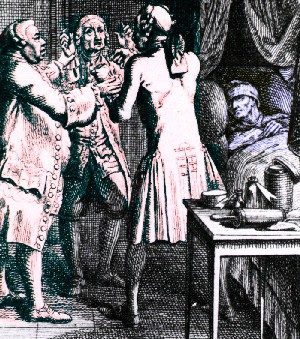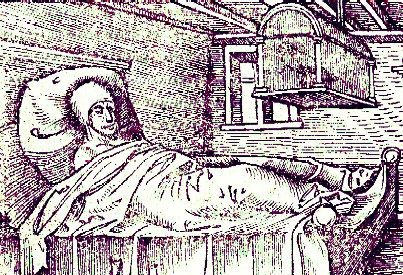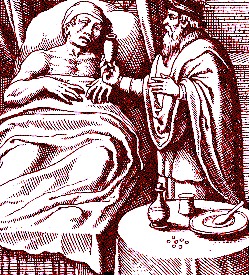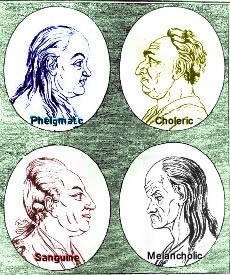
Fractures Page Menu: 1 2 3 4 5 6 7 8 9 10 11 12 Next>>
Fracture Treatment During the Golden Age of Piracy, Page 3
Fracture Repair Theory: Timing
The speed at which the bone should be set back into its proper place was discussed by period doctors. Hippocrates said that "in all cases of fracture, this object [setting the bone] should be attained then as quickly as possible."1 Sea surgeon John Atkins concurs, advising that setting fractured bones "is always to be done as soon as possible, to prevent the Pain, Tumor, and Inflammation that may be expected and which will certainly follow, if it is deferred too long."2

Doctors Debating, from Frontispiece of Medizinische
Annalen Fur Aerzte und Gesundheitliebende,
by Johann Gottlieb Frietze (1781)
Richard Wiseman explains that all surgeons "agree, the sooner [a fracture is set] the better... If at the first or second day the Fracture be not reduced it is in danger of Inflammation and Mortification [becoming gangrenous]."3 Wiseman cites the ancient physician Celsus who he notes tells surgeon to set the bone in the first or second day. "For indeed after the second day, it is supposed the Fracture is accompanied with great Defluxion [discharge of humors], and so yields not to Extension without hazzard of drawing such ill Accident upon itself."4
Ambroise Paré does not completely agree. He raises the problem of an inflamed wound site, advising "it is better, if it may bee done, to deferre the reducing thereof so long, until the [inflaming] humor which possesses the part be dissolved, the tumor abated, and the bitternesse of paine mitigated."5 However, he also explains that the operation "must bee performed in the first dayes, for afterwards there will happen inflammation"which could lead to complications such as inflamation6, so he is in favor of quickly setting a fracture which is not inflamed.
Matthias Gottfried Purmann similarly warns that a fracture "accompanied with a Contusion and Swelling, or a Dislocation of the next Joint, which causes such intolerable Pain, [makes it so] that the Fractured Part cannot be extended, [because] it often ushers in Cramps, Convulsions and Death."7
While Paré is not in favor of setting an inflamed fracture, he does agree that a surgeon "may easily restore a broken or dislocated bone, if presently, as soon as the mischance is got, or else the same day, you endeavour to restore it: for the biternesse of paine or inflammation, which may trouble the patient, is not as yet verie great, neyther is the contraction of the muscles upwards as yet very much or stubborne."8
1 Hippocrates, Hippocratic Writings, Translated and Edited by Francis Adams, p. 82; 2 John Atkins, The Navy Surgeon, p. 41 3,4 Richard Wiseman, Of Wounds, Severall Chirurgicall Treatises, p. 466; 5,6 Ambroise Paré, The Apologie and Treatise of Ambroise Paré, p. 166; 7 Matthias Gottfried Purmann, Churgia Curiosa, p. 213; 8 Paré, p. 167
Fracture Repair Theory: Rest

Ulrich von Hutten in bed From De morbo Gallico (1519
Rest was recognized as an important element in healing a broken bone. Paré explains that "rest is necessarie for the uniting of broken bones. For the Callus is easily dissolved, if they bee moved before their perfect and solid agglutination."1 Richard Wiseman said, "let me advise you not to be too hasty in taking the Patients out of their Beds; for in some Bodies the generation of Callus is very slow, and a new Distortion may happen, and ill Accidents follow."2
This brought up the issue of how long a patient was to remain immobile. Echoing his previous comment, Paré advises "that you cannot certainly set downe a time necessarie for the generating a Callus: for in some it happens later"3. Richard Wiseman advised his readers that "lesser Bones are perfected [healed] in fourteen, eighteen, or twenty five days, the bigger in forty to fifty"4.
1 Ambroise Paré, The Apologie and Treatise of Ambroise Paré, p. 164; 2 Richard Wiseman, Of Wounds, Severall Chirurgicall Treatises, p. 465; 3 Paré, p. 184; 4 Wiseman, p. 465
Fracture Repair Theory: Aspects of the Bone
Today, we recognize that that elements of the bone broken are important to the amount of time it takes for a fractured bone to fully heal - these include both the type of bone and type of fracture. Surgeons in the golden age of piracy also acknowledged the importance of these factors in healing.

Some Modern Simple Fracture
Types (OpenStax
College)
With regard to fracture location, Paré noted that a "longer time required to substitute a Callus to a great bone, than to a little one."1 Matthias Purmann found "a great difference in Fractures, in respect of the Part where... they happen". He goes on to explain that in the lower arm and leg there were two bones and "sometimes but one of them are broke and the other remains whole" which resulted in different methods of cure.2 John Atkins suggests that fractures were "better in the Arm, than Thigh or Leg; because the Position of the inferior Limbs is more disadvantageous and uneasy, and the Quiet of them necessarily more liable to be disturb’d."3
Proximity to a joint was also widely agreed to be problematic. Atkins explained that the danger of a compound fracture was more acute "as it is nearer to... a Joint"4. Purmann agreed, explaining that the "nearer a Joint the Fracture happens, the more difficult it is to Cure"5. Wiseman explains that fractures near a joint "are both more hard to be restored, and to be kept so restored; and because of the multitude of Symptoms, (which in such Wounds cannot but supervene,) are not without great difficulty to be cured."6 It is likely that the patient's tendency to move the joint caused problems with keeping the newly formed callus near it from being broken.
Although they didn't have X-Rays of bones that could help the surgeon to diagnose the type of break a bone contained, there was still some recognition that there were different sorts of fractures and some were more challenging to heal than others. Purmann noted that "some Bones have only a Fissure or Cleft; some are broke to that degree, that the Splinters of the Bones stick out at the Wounds; and others are broke Sloping with a Fissure."7 Wiseman talks about greenstick fractures, explaining that they are like "when you break a green Stick; it breaks but separates not: So is cured by a due Extension with little trouble to the Chirurgeon, or pain to the Patient after Extension is made."8 Such fractures are still called greenstick to this day.
Wiseman finishes his discussion on problems of fracture location on a practical note, explaining that "those Fractures are most dangerous which are made so deep in the Flesh parts, that your hands cannot well come at them, to extract the loose Bones, and place the other right, and retain them so by Bandage"9.
1 Ambroise Paré, The Apologie and Treatise of Ambroise Paré, p. 165; 2 Matthias Gottfried Purmann, Churgia Curiosa, p. 212; 3 John Atkins, The Navy Surgeon, p. 40; 5 Atkins, p. 63; 5 Purmann, ibid.; 6 Richard Wiseman, Of Wounds, Severall Chirurgicall Treatises, p. 419; 7 Purmann, ibid.; 8 Wiseman, p. 465; 9 Wiseman, p. 419-20;
Fracture Repair Theory: Patient Factors
Several aspects of the patient themselves impact the healing process. Today, it is recognized that the age of the patient and whether or not they are smokers contribute notably to the amount of time it takes for a fracture to heal. Although their understanding was different during the golden age of piracy, period surgeons also recognized that aspects of the patient and their body were important to healing.

De Efficaci Medicina Libri Tres, by Marco
Aurelio Severino, Title page (1646)
Modern studies find that proper nutrition is important to proper fracture healing.1 John Atkins likewise explained that creation of callus in a broken bone "depends chiefly on a Correction of Accidents [wounds, swelling and such, which fall under Wiseman's prescription for preserving tone] and a proper Nutritive Diet"2. Diet was also recognized as being important to the generation of a good callus by both Wiseman3 and Paré4.
The patient's age was also recognized as extending healing time for fractures during the late 17th and early 18th centuries. Ambroise Paré explained that "Fractures are more easily repaired in yong bodies than in old: for in these there is plenty of the primigenious and radicall [original/pure] moisture, that is laudably holding and glutinous; and in the other there is store of watrish and excremtitious [diluted with waste]."5 Wiseman also recognized that children "do best suffer Extension" while the elderly healed slowly.6

Artist: J.C. Lavanters
The Four Humoral Body Types
From
Physiognomische Fragmente
zur Beförderung (1783)
Period surgeons noticed another link between fracture healing time and the patient's body. One aspect of humor theory classifies people by body type. The four types include hot and cold aspects combined with moist and dry aspects of the body. Paré said, "A Callus sooner growes in sanguine [hot/moist], than in cholerick [hot/dry] bodies."7 He further explains that
all moyst bodies' can handle more adjustment, "for that they are lesse hurt by violent extension and pulling, by reasons of their native and much humiditie and softnesse. For thus skins of leather, moistened with any liquor, are easily retched and drawn out as one pleaseth: but such as are dry & hard, being lesse tractable, will sooner rend and teare, than stretch further out. Therefore the Surgeon shall use a meane in extending and drawing forth of members, as shall be most agreeable to the habits of the bodies.8
While he doesn't directly identify different humoral types, Wiseman does note that a patient of "an ill habit of body" recovered very slowly.9
1 For example, see Sanjeev Kakar and Thomas Einhorn, "Importance of nutrition in fracture healing," Nutrition and Bone Health, pp 85-103; 2 John Atkins, The Navy Surgeon, p. 50; 3 Richard Wiseman, Of Wounds, Severall Chirurgicall Treatises, p. 470; 4, 5 Ambroise Paré, The Apologie and Treatise of Ambroise Paré, p. 184; 6 Richard Wiseman, Of Wounds, Severall Chirurgicall Treatises, p. 466; 7 Paré, p. 165; 8 Paré, p. 168; 9 Wiseman, p. 465
Fracture Repair Theory: Environmental Factors
The last concern of period medical men sounds rather unusual to us; factors that came from the environment.

Photo: Wiki user maggieandcharles
Winter at Tintamarre Island, St. Martins - Hardly dry
Weather was considered an important factor to health and healing during this time. Paré says that "the constitution of the yeare and region" were relevant, referring (somewhat obliquely) to the weather and conditions present at a location.1
He expands upon this, noting "that in winter when all is stiffe with cold, by a little fall, or some such sleight occasion, the bones may be quickly and readily broken. For then the bones, being dryed by the drinesse of the ayre encompassing us, become more brittle... but when the season is moist, the bones are also more moist, and therefore more flexible and yeelding to the violence of the obvious and offending bodie."2
Of course, during the golden age of pirates, much of the action took place in the Caribbean, where winter was a little different from that experienced in Europe.
1 Ambroise Paré, The Apologie and Treatise of Ambroise Paré, p. 165; 2 Paré, p. 163

